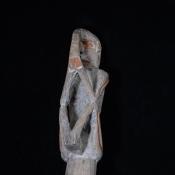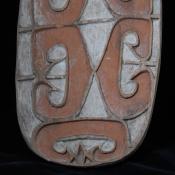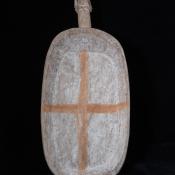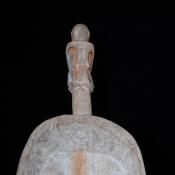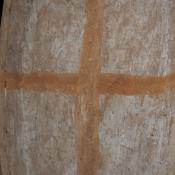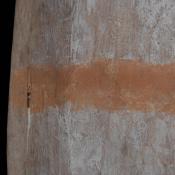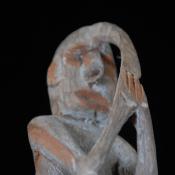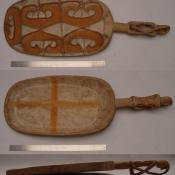This is a wooden Asmat sago platter carved from the wood of a sago tree. It was carved in the latter half of the twentieth century by an Asmat artist in Papua New Guinea. The main body features a symmetrical pattern of a sago tree, which is carved half an inch into the surface of the piece. The fronds of the tree are painted red and the backdrop is painted white. The edges of the platter are unpainted. The bottom surface of the piece was originally painted white, which has now since faded. A cross band of red pigment dissects the bottom surface into four quadrants. The handle at the top of the platter is carved in the likeness of a male figure with his knees bent and elbows resting upon his knees. His hands are connected to his forehead by a curved protrusion. The man’s face features an elongated mouth, sunken eyes, large nose, and protruding brow, all of which were painted red. The figure’s body and limbs feature trenches carved into their length which were painted red.
Platter such as these are used by Asmat peoples for the consumption of sago for meals. The designs of the sago tree represent the dependency and reverence of the sago tree among the Asmat. The sago is a core aspect of Asmat culture, as it provides food and building materials in great abundance. In much of Asmat belief, humans and sago trees are interchangeable, dating back to the myth of humanity’s creation at the hands of the Great Woodcarver Fumeripits.
The white pigment is called mbi and originates from mussel shells which are burned to ash and mixed with clay. Red wasah pigments are derived from clay and mud deposits located at riverheads and upstream villages. The heavy use of wasah is representative of an Asmat story in which the headless, limbless, featureless man Ofomin was murdered by a man who desired his wife. Ofomin’s blood ran into the ground and mixed with the waters to create red mud and clay. Platters such as this were also used to serve human brains until the banning of headhunting practices by missionaries in the late twentieth century. It is believed that the Capricorn beetle’s larval form resemblance to human brains is what contributed to its rise in popularity as a ceremonial dish as a replacement for human brains themselves.
Color: Brown, Red, White


